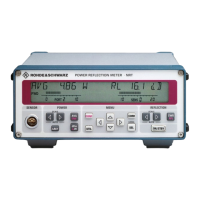Annex
NRP2
381User Manual 1173.9140.02 ─ 07
The measurement commands are obtained by adding one of the following keywords:
:DIFF (difference)
:DIFF:REL
(difference with reference value)
:RAT (ratio)
:RAT:REL (ratio with reference value)
:SWR (standing wave ratio)
:RLOS (return loss)
:REFL (reflection coefficient)
The list of parameters is modified for these commands since two sensors have to be
entered in the <source_list>.
Example:
MEAS:RAT DEF,3,(@1),(@4)
A CALCulate block is used for processing the measured values. Each CALCulate
block has two input channels called the primary and secondary channel. In the above
example, the primary channel is assigned sensor 1 and the secondary channel sensor
4 via the <source_list>. The measurement result is the ratio of the results from
sensors 1 and 4.
Example:
MEAS:SWR DEF,2,(@1),(@2)
It is assumed that sensor 1 delivers the forward power of a wave and sensor 2 the
reflected power of a wave. The measurement result represents the SWR of the two
power values:
1/@/2@1
1/@/2@1
P
Note that the unit is automatically set to percent (refer to chapter A.4.1.5, "Selecting
the output unit for measured values", on page 383
A.4.1.4 Selecting a measurement mode
Other
MEAS commands are available for measurements to be performed in a mode
other than the "ContAv" mode. The short form of these commands is obtained by add-
ing a keyword for the measurement mode to keyword MEAS.
Timeslot measurement:
MEAS:TSLot?
<tslot_width>,<no_slots>,<start_exclude>,<stop_exclude>
BurstAv measurement:
MEAS:BURSt? <dtolerance>,<start_exclude>,<stop_exclude>
Programming Measurements
北京海洋兴业科技股份有限公司(证券代码:839145)

